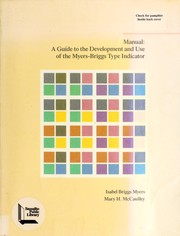Check nearby libraries
Buy this book

Last edited by 21-036 Putri Anggraini Sinulingga
August 27, 2023 | History
From the Introduction...
The purpose of the Myers-Briggs Type Indicator15 (MBTI®) is to make the theory of psychological types described by C. G. Jung (1921/1971) understandable and useful in people's lives. The essence of the theory is that much seemingly random variation in behavior is actually quite orderly and consistent, being due to basic differences in the way individuals prefer to use their perception and judgment.
Check nearby libraries
Buy this book

Previews available in: English
Showing 1 featured edition. View all 1 editions?
| Edition | Availability |
|---|---|
|
1
Manual, a guide to the development and use of the Myers-Briggs type indicator
1985, Consulting Psychologists Press
in English
0891060278 9780891060277
|
aaaa
Libraries near you:
WorldCat
|
Book Details
Table of Contents
1.
Introduction
Page 1
Overview of Jung's Theory of Psychological Types
Page 2
Identifying the MBTI Preferences
Page 3
Uses of the Indicator
Page 4
2.
Administering and Scoring the MBTI
Page 6
Populations Suitable for Testing
Page 6
Selection of the MBTI Form
Page 7
Administering the MBTI
Page 7
Using the Stencils
Page 8
Computer Scoring
Page 9
3.
The Theory Behind the MBTI
Page 11
The Four Functions: S, N, T, and F
Page 12
The Attitudes: Extraversion (E) and Introversion (I)
Page 13
Judgment (J) and Perception (P): Orientation to the Outer World
Page 13
The Theory of Type Development
Page 14
The Dynamic Interaction of Preferences
Page 15
Identifying the Dynamics from the Type Formula
Page 16
Example of Dynamics in Type ENTP
Page 17
Dynamics of the Type Descriptions
Page 1
Types are Created by Exercise of Preferences
Page 19
Learning Type through Study of Individual Descriptions
Page 19
4.
Understanding the Sixteen Types
Page 30
Placement of Types on the Type Table
Page 30
Terminology for Identifying Combinations of Types
Page 3
Characteristics of Groups of the Types
Page 31
Representative Type Tables
Page 38
Estimates of Frequencies of Types in the General Population
Page 45
Understanding of Type through the Personal Type Table
Page 47
5.
Initial Interpretation and Verification
Page 52
Introducing the Interpretation
Page 52
Introduction to Type as a Verification Tool
Page 53
Final Steps in Verification of Type
Page 56
Interpretation of MBTI Scores
Page 58
6.
Use of Type in Counseling
Page 63
Initial Interpretation
Page 63
Counseling for Type Development
Page 64
Making Full Use of Perception and Judgment
Page 65
Examples of Counseling Issues for Each Preference
Page | 68
Communication Styles for Counselors
Page 70
Counseling with Couples and Families
Page 71
Type Differences and Issues in Providers of Psychological Services
Page 73
7.
Using Type in Career Counseling
Page 77
Introduction
Page 77
Type Development and Career Counseling
Page 77
Expectations of Work Choices for Each MBTI Preference
Page 78
Occupation and MBTI Preference
Page 78
Other Issues in Careers and MBTI Types
Page 89
8.
Uses of Type in Education
Page 95
Type and Learning
Page 95
Type and Teaching
Page 133
The Administration of the Educational Process
Page 136
9.
Construction and Properties of the MBTI
Page 140
Development of MBTI Items
Page 141
History of the Development of MBTI Forms
Page 142
Item Analyses and Selection of Items
Page 146
10.
Reliability
Page 164
Internal Consistency Reliability Estimates
Page 165
Test-Retest Reliability Estimates
Page 170
11.
Validity
Page 175
Evidence for Validity from Type Distributions
Page 176
Correlations of MBTI Continuous Scores with Other Scales
Page 176
Comparison of the MBTI and the Jungian Type Survey
Page 209
Comparison of MBTI Types with Self-Estimates of Type
Page 209
Studies of Behavioral Differences of the Types
Page 210
Studies of Creativity
Page 214
Other Representadve Studies of Type Differences
Page 215
Introversion and the Preference for Privacy
Page 221
Type and Culture
Page 223
MBTI Research Resources
Page 223
Appendix A.
Glossary
Page 224
Appendix B.
Sources and Description of Samples
Page 227
Appendix C.
Mean Preference Scores for MBTI Preference by Age Groups
Page 239
Appendix D.
Types of Populations
Page 243
Ranking of occupations by preference for.
EI
Page 244
SN
Page 246
TF
Page 248
JP
Page 250
ST
Page 253
SF
Page 255
NF
Page 257
NT
Page 259
ISTJ
Page 261
ISTP
Page 263
ESTP
Page 265
ESTJ
Page 267
ISFJ
Page 269
ISFP
Page 271
ESFP
Page 272
ESFJ
Page 274
INFJ
Page 276
INFP
Page 278
ENFP
Page 280
ENFJ
Page 282
INTJ
Page 284
INTP
Page 286
ENTP
Page 288
ENTJ
Page 290
Notes.
Page 293
References.
Page 296
Edition Notes
Bibliography: p. 296-309.
Classifications
Contributors
The Physical Object
ID Numbers
Community Reviews (0)
Feedback?History
- Created April 1, 2008
- 14 revisions
Wikipedia citation
×CloseCopy and paste this code into your Wikipedia page. Need help?
| August 27, 2023 | Edited by 21-036 Putri Anggraini Sinulingga | Update covers |
| March 17, 2021 | Edited by ImportBot | import existing book |
| March 3, 2021 | Edited by MARC Bot | import existing book |
| November 2, 2020 | Edited by MARC Bot | import existing book |
| April 1, 2008 | Created by an anonymous user | Imported from Scriblio MARC record. |













